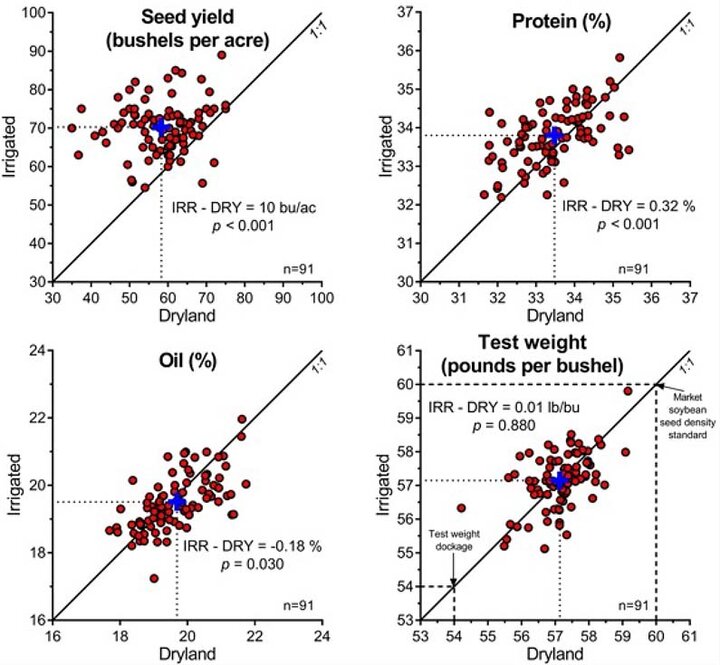
A continuous increase in U.S. soybean yield due to better genetics and agronomic practices has been accompanied by a continuous decline in seed protein concentration. This is becoming a problem for soybean processors aiming to produce a high-protein soybean meal.
Nebraska is ranked as the fourth-largest soybean producer state in the U.S. About 50% of Nebraska soybean acreage is irrigated; the rest is dryland and exposed to water limitation in years with insufficient and/or ill-distributed in-season rainfall. As a result, yields are typically higher and more stable with irrigation compared with dryland conditions.
Previous studies have shown that seed protein concentration tends to decline with increasing yields; therefore, one would expect — in principle — seed protein to decrease with higher yields under irrigated conditions. However, the extent to which water regime (irrigated versus dryland) affects seed constituents — in particular, protein concentration — has not been evaluated.

To answer this question, our research team at the UNL Department of Agronomy and Horticulture initiated a project, with support from the Nebraska Soybean Board. With the help of 17 UNL Extension Educators, we collected soybean seed samples from a total of 91 soybean producers during the 2019 and 2020 growing seasons. Each producer was asked to submit samples from both irrigated and dryland fields. Soybean seed samples were analyzed for protein and oil, and test weight was also determined. The surveyed fields represent well the soybean production area distribution within the state and the associated range in weather, soil and management practices (Figure 1).
The pooled data from 2019 and 2020 is presented in Figure 2 and shows a comparison of yield, seed protein and oil concentration, and test weight in irrigated (vertical axis) versus dryland fields (horizontal axis). Data points above the 1:1 line indicate higher data values in irrigated than in nearby dryland fields and vice versa. The average yield was 10 bu/ac higher in irrigated versus dryland conditions.
The three cases in which yield was higher in dryland versus irrigated conditions were scenarios in which irrigated fields suffered yield losses due to weed infestation, or received ill-timed sub-optimal irrigation amounts, or were planted late. There was no difference in the bushel test weight between irrigated and dryland fields. However, the average test weight (57 lb/bu) was 3 lb per bushel lower than the standard soybean market test weight of 60 lb/bu.
Contrary to our original hypothesis, irrigated fields exhibited higher protein (+0.32%) than nearby dryland fields but had slightly lower oil (-0.18%). In other words, both yield and seed protein were higher in irrigated versus dryland fields, which means Nebraska soybean producers can produce high yields with high protein concentration under irrigated conditions. Aside from economic considerations, this result is also interesting from a scientific perspective as irrigation seems to be a practice that breaks the typical trade-off that one would expect between yield and seed protein (i.e., a lower protein with higher yield).
